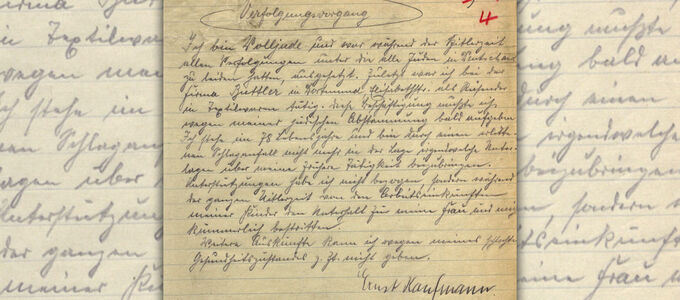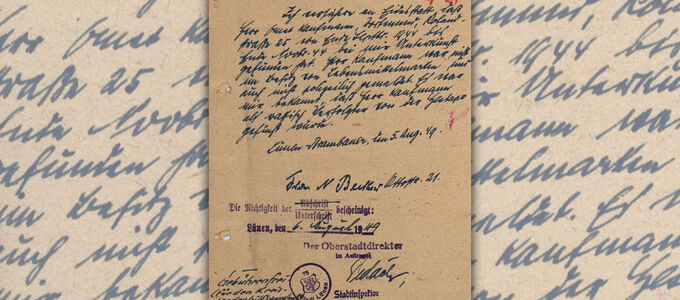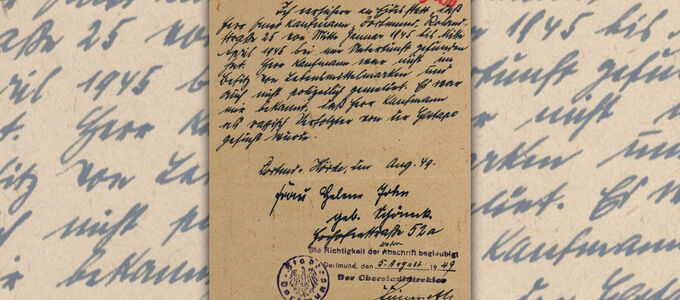
He lost everything and found refuge with brothers and sisters in faith: Ernst Kaufmann, who was of Jewish descent, survived because people in his New Apostolic environment hid him from the Gestapo. Here is a short biography of him to mark the International Day of Commemoration in Memory of the Victims of the Holocaust, which is observed annually on 27 January.
Dortmund, Rolandstrasse 25. The two men came unannounced. They searched the home of Luise and Ernst Kaufmann. And they found what they were looking for: a briefcase with 5,930 hard-earned Reichsmark, and family jewellery worth 2,000 Reichsmark. They took everything.
The couple did not dare oppose them. They watched helplessly as they were robbed. The two “gentlemen” were from the Gestapo, the Secret State Police, and the year was 1936. That year Ernst Kaufmann had also lost his job. He was now without an income and without his assets.
Determined and effective
Ernst Kaufmann had been determined early on and became a successful businessman. He had attended secondary school, had been awarded his school leaving certificate, and completed a commercial apprenticeship in Cologne. During the First World War he was drafted. This was in 1916 and by then he was already 40 years old. After the war, he opened a fabric shop in Dortmund and a second one in Brambauer. He had up to 20 sales representatives working for him.
His business experienced a crisis in 1925. Fortunately, new prospects opened up. He was employed by a company and sold electrotherapy devices and made a lot of money. Despite his success, Ernst Kaufmann was dismissed in the summer of 1936. That was the same year his entire fortune was stolen. And both events had the same reason.
Ostracised and treated with hostility
Ernst Kaufmann was of Jewish origin. The Nuremberg Law for the Protection of German Blood and German Honour enacted in 1935, marked the end of his professional success. It was an anti-Jewish law with the aim to eliminate Jews from German society. When the National Socialists came to power, anti-Semitism had become a government programme.
As a so-called full Jew who lived in a privileged mixed marriage he did not have to wear the Yellow Star that was introduced in September 1941. That meant that he would not be deported to camps or be crammed into a ghetto—but only for the time being. Later, even such people were threatened with deportation.
On the run from the Gestapo
Ernst Kaufmann and his Aryan wife were increasingly marginalised and subjected to hostile actions. At the end of September 1944, Ernst Kaufmann saw no other way out than to go into hiding. The Gestapo was watching him closely. Kaufmann, who had become New Apostolic in 1923, had perhaps heard of the fate of his friend and brother in faith from Dortmund, Harry Fränkel. Fränkel had already been murdered in Auschwitz by 1944.
From the end of September 1944 to mid April 1945, friends took Ernst Kaufmann in. Several families had taken him in during this time, hiding him in their often cramped flats, sharing their meagre food rations with him. At first he stayed with his friend Karl Beyersdorf in Dortmund, then with Natalie and Bernhard Becker in Lünen. Then Hilde Meier and her parents in Dortmund-Hörde had taken him in at the end of November 1944. His last hiding place was with the family of Helene and August John.
Saved but broken
Everyone had to be careful for fear of the neighbours noticing anything. If they had discovered him, it would have meant certain death. And informers were lurking everywhere. Only the frequent and dangerous moves prevented him from being discovered. It was only when the American troops arrived that Ernst Kaufmann dared to come out of hiding.
This is how he managed to escape arrest by the Gestapo and death in an extermination camp. But he had been ill and poor for a long time. When the decision for compensation finally came, on 16 June 1955, it was too late for him, because he had died 13 days earlier at the age of 78.
The network of rescuers
Who were his rescuers? It was a whole network of several families and accomplices. All of them belonged to his church. Church records and civil documents prove this.
The Church leadership was aware of the rescue operation, as reported by family members and companions. First, there was District Apostle Hermann Dietrich Magney, who had pledged his support. And during the rescue operation, his successor, Peter Kuhlen, took over.
The rescuers had put their lives on the line for their brother in faith. His discovery would have meant certain death for them. Ernst Kaufmann owed his survival to their resistance and rescue, a form of civil courage.
A detailed account of Ernst Kaufmann’s fate can be found in the book “Inszenierte Loyalitäten? Die Neuapostolische Kirche in der NS-Zeit” (Staged loyalties? The New Apostolic Church in the Nazi era), Berlin 2020, by Dr Karl-Peter Krauss, which has gained widespread recognition among experts. Preliminary work on the biography was done by Prof Günter Törner.












